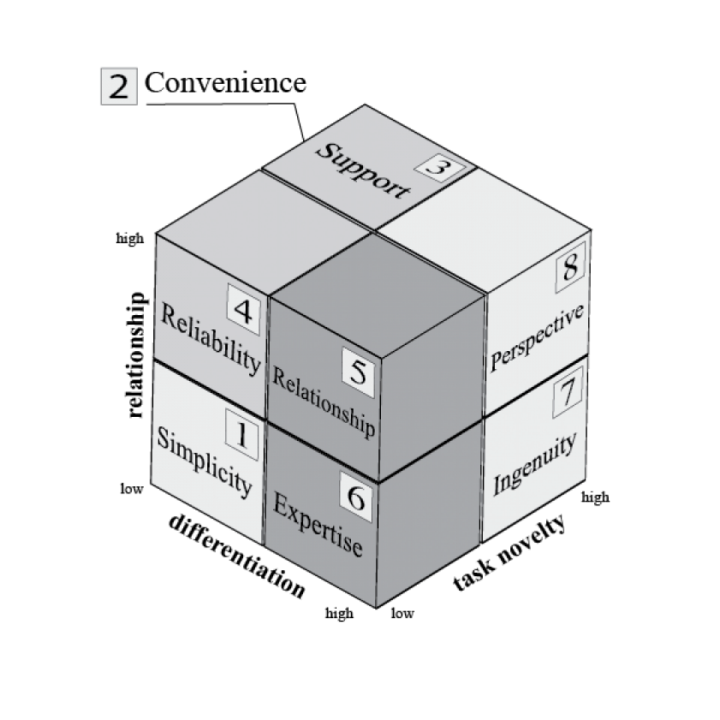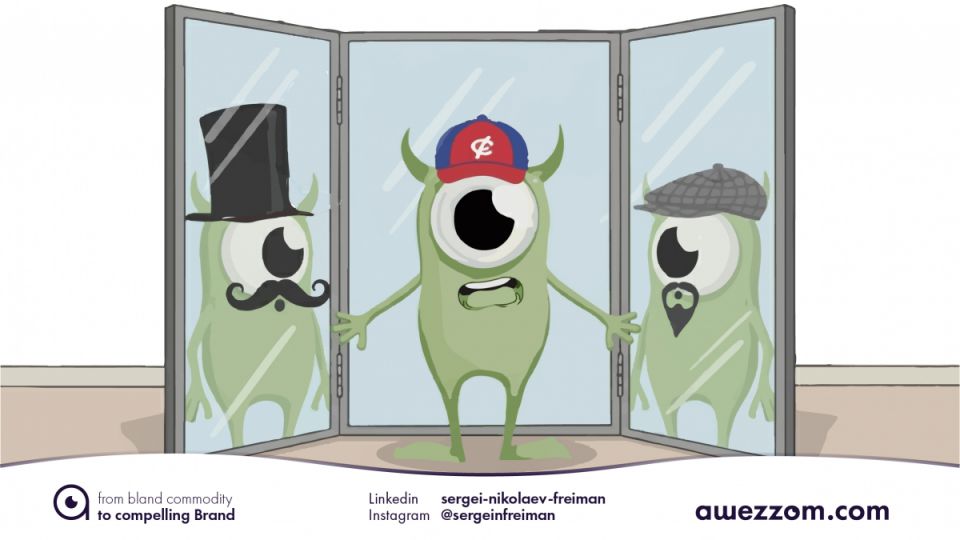This article originally appeared in Attorney at Work in December, 2024. You are reading an alternative, augmented version of the original article. The need for an update comes from recently identified additional buyer categories and ensuing commentary that haven’t been included in the original piece.
It is a firm and widespread belief among practitioners and professionals that the one and only kind of client relationship a service provider should strive for is that of a Trusted advisor. Everything else is perceived as falling short of an ideal. However, is that really the one and only success route?
In their bestselling classic, the authors of the Trusted Advisor proposed four client-advisor relationships, and encouraged professionals to aspire themselves to reach the pinnacle, namely the highest status of trusted advisors (Maister, Green & Galford, 2000). However, to this day, there seem to be substantial number of professionals and firms that haven’t obtained such standing. Hence, continued interest in the topic.
What is intriguing to me: this apparent shortcoming (not being a trusted advisor yet) does not seem to undermine professionals’ ability to continue making good money. Surely, in 25 years time since the publication of the book as well as all the non-stop buzz, there’s been plenty of opportunity for everyone (well, most professionals) to become trusted advisors.
Through workshops, training and coaching — the demand is there — this could’ve become a new normal. Those who would have failed, should’ve been out of business by now. Senior professionals should’ve passed their highest-status skills onto journeyman professionals and associates. How come we keep hearing the same old same old when an idea of nurturing trust-based relationships is supposedly common-sense stuff among professionals?
It appears to me that there are (and have always been, and forever will be) three other, alternative success routes for professionals.
Four successful types of relationships
Based on breadth of business issues and depth of personal relationships dimensions, Maister, Green and Galford proposed the following four types of client relationships: service-based, needs-based, relationship-based, and trust-based. I refer to such typology as follows:
- Service provider,
- Problem solver,
- Insightful ally, and
- Trusted advisor.
While the latter type seems to be preferable to other types, authors themselves state: “there are times when it is perfectly appropriate and right for a relationship to be a service based, or needs based” (Maister, Green & Galford, 2000).
This brings up an important distinction to keep in mind: vendor types and client relationships are not one and the same thing. In other words, a vendor may be proficient in various relationship types. However, this only works downstream.
For example, a Trusted advisor may occasionally engage in lower-tier relationships with clients. At the same time, a Service provider will find it challenging to act effectively in a higher-tier manner. Problem solvers may act confidently in service-based and problem-solving relationships, — preferring the latter —but will be inadequate in Insightful ally and Trusted advisor roles.
There is, of course, another side to this relationship coin, namely the buyers’ perspective. Having studied the works of Thomas Nagle (et al.) and Reed Holden — pricing specialists — my investigations into buyer behavior allowed me to identify eight generic buyer types:
- Simplicity buyer,
- Convenience buyer,
- Support buyer,
- Reliability buyer,
- Relationship buyer,
- Leadership buyer,
- Ingenuity buyer, and
- Perspective buyer.
The model in Figure 1 represents a three-dimensional map of buyer typology. It is based on motivations that drive buying behavior. The reason behind such a 3D representation rests with three fundamental dimensions that govern buying proclivities:
- interest in differentiation,
- interest in relationships, and
- degree of complexity.

Any healthy relationship always takes two to tango. Relationships work best when both sides want the same from the relationship. Therefore, a buyer signals what kind of relationship it seeks with the service provider. And the service provider, on the other hand, through their actions attracts certain buyer types. Table 1 shows correspondences between buyer types and client relationships.
| Vendor | Buyer |
|---|---|
| Service provider | Simplicity |
| Convenience | |
| Problem solver | Leadership |
| Ingenuity | |
| Insightful ally | Support |
| Reliability | |
| Trusted advisor | Relationship |
| Perspective |
Combined with my proposition of eight generic buyer types, the fact that many professional services firms and practitioners continue to be in business regardless of the coveted trusted advisor status suggests that the other three client-vendor relationships are viable success alternatives.
For example, Problem solvers prefer working with Leadership (octant 6) and Ingenuity (octant 7) buyers who, in turn, seek vendors capable of problem-solving, — not just service provision — and simultaneously dismiss relationship building.
The mapping proposed in Table 1 helps with matching relationship types with buyer types. Understanding how to read this map, will allow professionals identify win-win opportunities where neither of the parties to the transaction takes advantage of another.
Reading the map
The 3D map suggests the following. If you’re already a Trusted advisor, it makes absolutely no sense to work with Simplicity and Convenience buyers (octants 1 & 2). It’s madness to think that investing time and resources in understanding the client, becoming a safe haven for hard issues, or giving considerate advice will ever pay off when the client has absolutely no interest in solving wicked problems and building a long-term relationship. However, as a Service provider, it’s prudent to sell bare bones services to the Simplicity and Convenience buyers. Everyone wins.
Put differently, a Trusted advisor could serve octant 1 and 2 buyer types effectively and efficiently if it prunes activities associated with typical advisory services. But what’s the point? Why deliberately compete with lower-tier vendors? Given the aquired higher-tier skills, it makes more sense to work with clients who seek such skills.
Similarly, a Problem solver could serve Simplicity and Convenience buyers profitably and efficiently if they dispense with actual problem-solving activities and focus on execution and control value activities.
Yes, I understand the argument: “We have to take responsibility for our clients who know little to none about the intricacies of our craft.” However, such thoughtfulness is often underappreciated, unwanted, or worse — rejected. Not to mention the sustainability and competitiveness of your practice. While your rivals give clients what they want, and turn a profit, you might be getting paid the same yet giving away your additional time, knowledge, skills, and effort for free.
There is a total of four different ways how to manage buyer-seller relationships profitably. Trusted advisor is one of them. As the map and correspondences table suggests, the most beneficial client types for a Trusted advisor are octant 5 and 8 types — Relationship buyer and Perspective buyer.
Knowing this will help you improve prospect qualification. If yours is a practice that wants to serve clients in a capacity of a Trusted advisor — and thus build out such market reputation — you should turn down other buyer types as much as possible. To be intentional about this, you may want to rank order your clients. Obviously, for a Trusted advisor, your A clients will (mostly) be octant 5 & 8 buyers, and your F clients — octant 1 & 2 buyers.
Conclusions
Fueled by what many clients perceive as self-aggrandizement and pompousness, this Trusted advisor’s badge is often self-assigned. Reflected in service provision, such status symbol has to have substance to back it up.
If you already have access to (e.g.) Simplicity buyers, have the same perceptual frames as they do, and your practice can make good money this way, — (e.g.) through speed, efficiency, bare-bones service — there is absolutely no need to becoming a real Trusted advisor. Transitioning to another relationship type will always change clientele makeup. And this might not be what you really want and need for your practice.
Of course, one may always call itself a Trusted advisor regardless of client composition. Whatever makes one feel warm in a dark suit, as they say. However, in my experience, it’s beneficial to have a clear understanding of the type of practice one’s building, and not confusing the practice with oneself.
There is nothing wrong with not being a Trusted advisor and not running such a practice. From the business stand point, there are three other success routes you can be proud of. Different practice types serve different clients. Whichever you consciously choose, your choice is correct.
References
Holden, R.K. (2016). Negotiating with Backbone: Eight Sales Strategies to Defend your Price and Value. 2nd edition. New Jersey, US: Pearson Education.
Maister, D.H., Green C.H. & Galford R.M. (2000). The Trusted Advisor. New York, NY: Free Press, pp.7-10.
Nagle, T.T. & Hogan, J.E. (2006).The Strategy and Tactics of Pricing: A Guide to Growing More Profitably. 4th edition. New Jersey, US: Pearson Education.
Nagle, T.T. & Müller G. (2018). The Strategy and Tactics of Pricing: A Guide to Growing More Profitably. 6th edition. New York, US: Routledge, Taylor & Francis Group.
The awezzom question of the day:
Which relationship type is most beneficial for us and our clients given their wants and our current capabilities?

